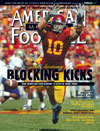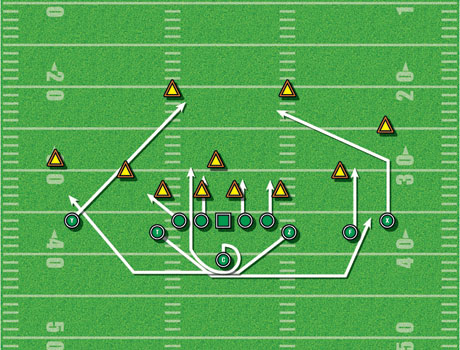AMERICAN FOOTBALL MONTHLY THE #1 RESOURCE FOR FOOTBALL COACHES
Article CategoriesAFM Magazine
|
The Wildcat SpinPlays for the two-minute offenseby: Brad Scott Head Coach, De Soto High School © More from this issue The two-minute offense has always been a main emphasis of our situational offensive package. We want our players to be confident in a two-minute situation because we have drilled it in practice and executed it before the half and at the end of games. Not only do our players have to make our plays successful by understanding each responsibility, they also have to understand how to manage the clock. For example, one of the main rules we live by is when to get out of bounds. We teach our players to get out of bounds if they are between the hash mark and the sideline when they have the ball. If they have the ball in between the hash marks, then they try to get as much yardage up the field as they can. We always begin with the formations. We only run one formation in our two-minute offense. We will be in a doubles look with both of our outside receivers 12-15 yards from the offensive tackle. Our inside receivers line up the same one yard by one yard alignment from the tackles. The difference for us is the fullback. Normally in our Wildcat Spin offense, he would line up in front of the quarterback and offset to the side. In this situation, he goes to the wide side of the field and splits the difference between our outside and inside receivers. At this point in the game, we still want the ability to run the football. We feel there will be a time when we not only want to run, but it is a better call to run the ball rather than throw it. When this occurs, we still keep our spin run game concepts intact. The first play we like to run in this situation is our sweep play (See Diagram 1). The simplicity of the play is that no one on offense changes any assignment. Our outside receiver on the play side must still push-crack the near safety. Our inside receiver will still arc release and block the play side corner. Our fullback will keep his same assignment even though he is now in the middle of a trips formation. He is responsible for the first alley run support player. In most defenses, this would be the outside linebacker. The offensive line will reach block play side with the back side guard pulling and turning up on the first bad color to show. Our back side receiver will try to get across the face of the near safety. Our spin motion and action will remain the same in the backfield with the QB jabbing and spinning to hand the ball to our inside receiver. The QB will then continue his run fake up into B gap.
Responsibilities: PST - Step: Bucket – Crossover; Reach the DE. PSG - Step: Bucket – Crossover; Reach the 1st man outside. C - Step: Bucket – Crossover; Reach the 1st man outside. BSG - Step: Pull – Wrap; Get into alley and hit 1st bad color. BST - Step: Bucket – Crossover; Reach the 1st man inside. X - Step: Push Crack the near safety. Q - Step: Jab play side, pivot; Handoff to IR, continue spin into B Gap faking blast. F - Step: Zone play side, block 1st alley force defender. T - Step: Pivot/Crossover, aim for hip of Q; take handoff and follow lead blockers to the #’s. Z - Step: Arc to Corner. Y- Step: Zone inside; crack near safety. The next play we like to run is our reverse play (See Diagram 2). Once again, no assignments change from the normal reverse. The play side outside receiver will push- crack the near safety. The inside receiver on the play side will go in motion and take a sweep fake. The offensive line will reach block play side with the backside guard pulling to attack the first bad color. The backside receiver will try to get across the face of the near safety. Our fullback, who would normally line up in the backfield, will still block the corner. Our receiver will take the reverse handoff from the spin of the QB and look to chase our pulling guard and the lead block from the fullback. Once again, we teach them to get out of bounds if they are outside the hash. If they have cut it up, then they get as many yards as they can up the field.
Responsibilities: PST - Step: Bucket – Crossover; Reach the DE. PSG - Step: Bucket – Crossover; reach the 1st man outside. C - Step: Zone Backside; Dead block for BSG to pull. BSG - Step: Pull – Wrap; Get into alley and hit 1st bad color. BST - Step: Zone play side; inside half of DE. Y - Step: Push crack the near safety. Q - Step: Jab play side, pivot; Fake handoff to IR and continue spin to handoff to other IR. Continue fake into B gap, chip any leaks. F - Step: Arc to corner. T - Step: Pivot/Crossover, aim for hip of Q; Take handoff and follow lead blockers to the #’s. Z - Step: Pivot/Crossover, aim for hip of Q; Fake 9 Sweep. X - Step: Zone inside; Crack near safety. The final running play we utilize is the Quarterback Blast play. This one has one minor wrinkle to it. In the blast play from our base formation, the fullback is responsible for J-blocking the EMLOS. He can’t do that from his alignment in the spread formation. So we use the blocking scheme from our Dive running play, coupled with the backfield action from the Blast play. In the Dive play, we instruct our linemen to base block the defensive front. Everyone blocks the nearest defender and tries to turn him out. Our backfield will fake the sweep play. As our QB spins, he will continue all the way around and then attack the play side B gap looking for a crease. The other inside receiver will carry out his reverse fake hoping to draw the outside linebackers away from the interior of the defense (See Diagram 3).
Responsibilities: PST - Step: Zone play side; Inside half of DE. PSG - Step: Zone play side; Inside half of DT. C - Step: Zone play side; MLB. BSG - Step: Zone play side; Inside half of DT. BST - Step: Zone play side; Inside half of DE. Y - Step: Push crack the near safety. Q - Step: Jab play side, pivot; fake handoff to IR and continue spin into the B Gap. Attack open window. F - Step: Zone inside; Inside half of nearest defender off the LOS. T - Step: Pivot/Crossover, aim for hip of Q; fake 8 Reverse. Z - Step: Pivot/Crossover, aim for hip of Q; fake 9 Sweep. X - Step: Zone inside; crack near safety. With these three run plays that complement the spread passing attack that we utilize in a two-minute situation, we feel like we can execute and be successful when this occurs. In addition, the run plays complement each other so the defense has to defend both edges and the middle on any given play. This takes advantage of one of the main philosophies of our offense: we want our opponent to defend the width and the depth of the field on every snap. WHAT IF? Q1. What if you’re in a situation where you’ve called the Blast and you see an all out defensive blitz? If I see it and the kids don’t, we can either call time out, or stay with the play. Most of the time we stay because the down blocking scheme will pick up an inside blitz. The outside LB doesn’t know it’s blast, so he will honor the sweep which allows us to get underneath and with no backside pursuit, we should bust a huge play. If the QB sees it, he can audible to option or dive, depending on where the LBs are coming from. Q2. What if you can’t block the EMLOS on the Quarterback Blast play with the blocking scheme from the Dive play? What is your next option? We can do one of two things. If we are having a hard time with the J block of the F on the EMLOS, we will base him out with the tackle and lead the F on the ILB like a traditional ISO blocking scheme. In our Dive blocking scheme, we can fold the 1 tech to the MLB and block out with both tackles as well. Q3. What if you’ve called your Sweep play and you’re facing a 30 Stack? Do blocking responsibilities change? Are there any adjustments? We do not assign specific defenders to our blocking schemes; instead we focus on our hat and pad placement in an area and then picking up the ‘first bad color.’ For example, on sweep, our front side linemen are going to reach, rip and run to the first man outside of them. So the play side tackle, who has a head up defender, might block the man on him, or the stacked linebacker depending on the stunt the 30 defense has called. If the defender slants inside, the play side guard will pick him up and the tackle will climb to the LB. If the defender slants outside, the tackle picks him up, and the play side guard will get the stunting LB. Our backside guard will pull and look for the first alley runner he sees. It doesn’t matter what front, only that our kids understand the concept assigned to their position on the run play called. |
|
| HOME |
MAGAZINE |
SUBSCRIBE | ONLINE COLUMNISTS | COACHING VIDEOS |
Copyright 2024, AmericanFootballMonthly.com
All Rights Reserved







